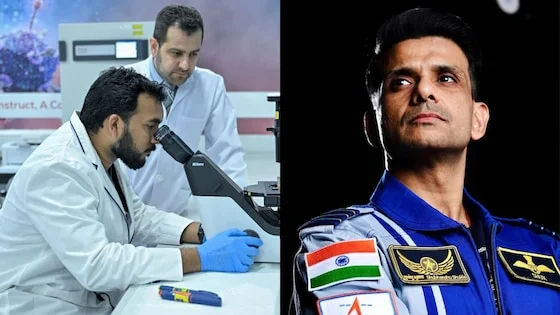
Indian Astronaut to Conduct Key Experiments on ISS: Diabetes, Crop Growth, and More
Indian astronaut Group Captain Shubhanshu Shukla is preparing for a groundbreaking mission to the International Space Station (ISS) scheduled for May 29th, 2025. As part of the Axiom-4 (Ax-4) mission, a collaborative effort between NASA, ISRO, and ESA, Shukla will join astronauts Peggy Whitson, Tibor Kapu, and Sławosz Uznański-Wiśniewski to delve into the effects of space on living organisms. This mission aims to understand how life adapts in space, potentially revolutionizing our approach to long-term space travel and healthcare on Earth. The mission's insights will also contribute significantly to India's first human mission, Gaganyaan.

Key Experiments Aboard the ISS
Among the seven experiments, one significant focus is on diabetes. The "Suite Ride" initiative will use Continuous Glucose Monitors (CGMs) to study blood glucose level fluctuations in the stressful space environment. The ultimate goal is to demonstrate that astronauts with insulin-dependent diabetes can be safely monitored and treated during space missions, potentially opening doors for a more diverse astronaut corps. This experiment has a Earth ground impact, with the potential to greatly improving diabetes monitoring and care in remote or underserved areas.
Another fascinating experiment involves studying the growth of crops in microgravity. Shukla and his team will analyze whether salad seeds like green gram (moong) and fenugreek (methi) can sprout and grow in space. This research aims to determine if astronauts can cultivate their own food in space, ensuring a sustainable food supply for extended missions. The experiment will focus on how plants change over generations, the effects of microbes, and the nutritional value of space-grown crops.

Exploring Microgravity's Impact
The mission will also examine muscle loss in space. Under microgravity conditions, astronauts can experience up to 30% muscle loss due to disrupted myogenesis. Shukla's mission will investigate how interventions like supplements can mitigate this issue.
Additionally, the team will research water bacteria (cyanobacteria) to understand their growth and oxygen production in space. This research could lead to self-sustaining oxygen systems for long-duration space missions.
From Water Bears to Computer Interactions
The team will also study tardigrades, tiny creatures known for surviving extreme conditions, to see if they can reproduce in microgravity. Furthermore, an experiment will analyze astronauts' interaction with computers, focusing on hand and eye movements and potential stress while using digital systems.
Implications for Gaganyaan
According to ISRO chairman V Narayanan, the results of these experiments will directly contribute to the success of Gaganyaan, India's first human spaceflight mission. The mission is also valuable with studying the growth rate of cyanobacteria, which may offer the key to deep space exploration and long term presence of humans on the moon or other planets: a self-sustaining system for oxygen production without need for resupply from earth. Speaking at a press conference in Delhi, he noted, “The Axiom-4 mission is expected to go up in the first week of June. The final date is not yet finalised. The mission is going to carry out several experiments — biological experiments, science experiments. This mission will provide first hand experience to our astronauts to work in the space environment, perform experiments, collaborate with others. All this is going to feed into our own Gaganyaan programme. Our key goal right now is to successfully carry out the Gaganyaan mission. All our efforts, including the experience we gain from the Axiom-4 mission, are geared towards that.”
What other innovative experiments do you think could benefit from being conducted in space? Share your thoughts in the comments below!